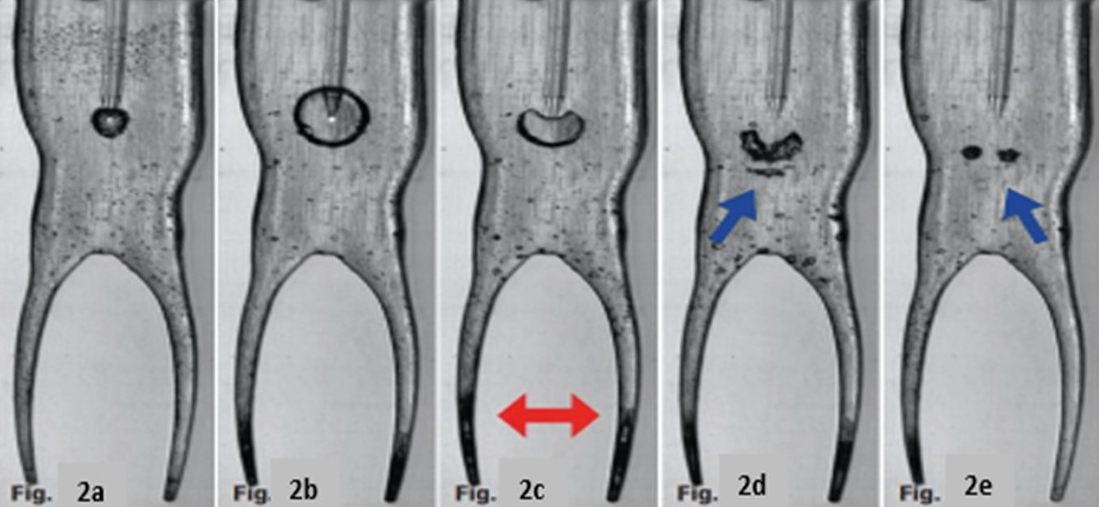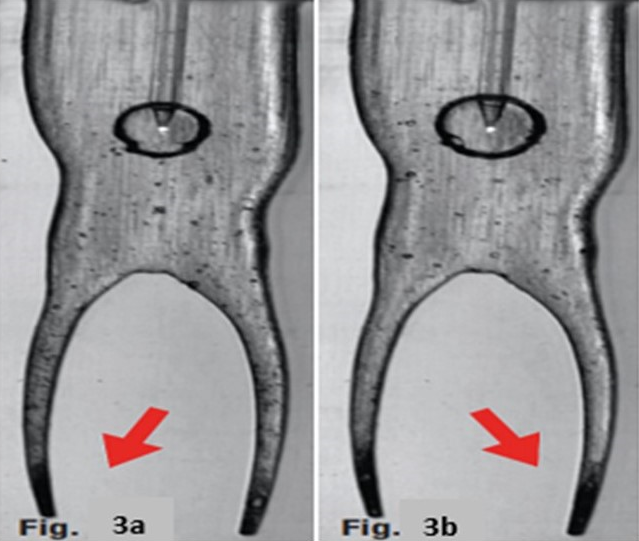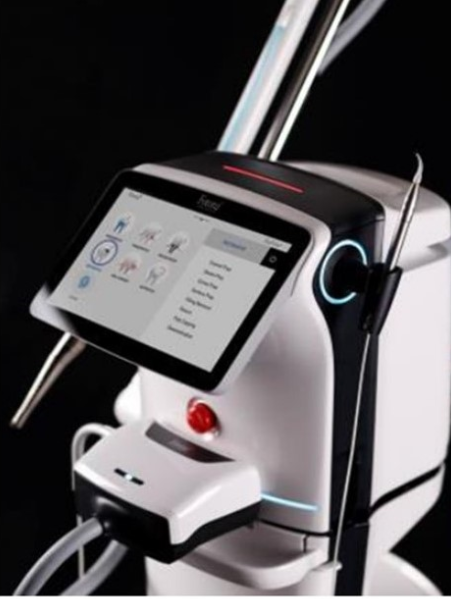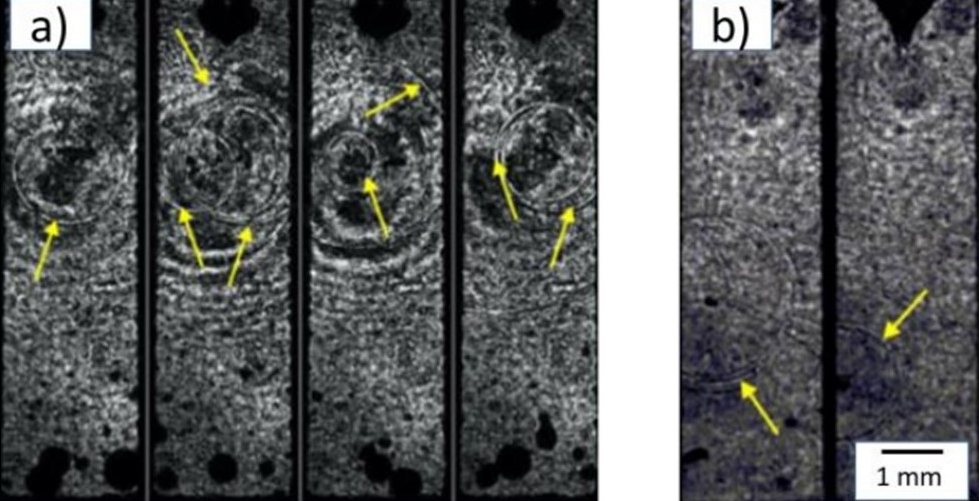Introduction
During root canal therapy, complete removal of soft tissues, diseased debris and bacteria remains a difficulty. Canal preparation, due to the complex nature of root canal morphology, leaves untouched areas and develops hard-tissue debris, which can become trapped in root canal irregularities, fins and isthmuses, preventing proper cleaning and disinfection. Irrigation is critical for sterilizing both the main root canal and the isthmuses. Conventional syringe irrigation is the most extensively utilized irrigation method. Fluid penetration is restricted in the apical canal and beyond the main canal due to the intricate three-dimensional microstructure of the root canal system, and it is usually unable to flush away tissue residues and dentine debris. The accumulated hard-tissue debris (AHTD) might compromise the sealing ability of root canal filling materials and impede disinfection.1
Laser Activated Irrigation (LAI) has become a potent technique of irrigation of the root canal2 and is linked to a rising interest with the use of erbium lasers to agitate water-based fluids in the intra-canal environment. The impact of laser activation is performed by cavitation, which involves the formation of vapor bubbles at the fiber tip that expand and then collapse. An example of this is the photon-induced photoacoustic Streaming (PIPS) method that uses low energy (10 or 20mJ) and short pulse length (50μs) to create peak power spikes and intense shock waves in water with minimum thermal effect. It has been shown to be more successful in eliminating debris from root canal irregularities than syringe irrigation and Ultrasonically activated irrigation (UAI).3 However, Verstraeten et al.4 found that the differences between PIPS and UAI in eliminating AHTD from mandibular molar mesial roots were not significant.
Recently, a novel shock wave enhanced emission photo acoustic streaming (SWEEPS) technology was developed to increase the cleansing and disinfection efficiency of the PIPS method by placing a laser fiber tip in the access cavity filled with irrigation fluid and emitting a pulsed laser light into the fluid.5 SWEEPS works in a similar way to PIPS, but it has a distinct mechanism of action in that it sends pulse pairs into the liquid.6 The SWEEPS irrigation process amplified pressure waves more than the traditional PIPS irrigation process, which only emitted a single Er:YAG pulse.5
The aim of this review is to offer the most relevant data on a novel SWEEPS (shock wave enhanced emission photoacoustic streaming) technology, its relative advantages, with an emphasis on single-pulse SSP laser-assisted irrigation and dual pulse SWEEPS technology, as well as provide recommendations for the use of SWEEPS technology in Endodontics based on current evidence.
Lasers in Endodontics
Lasers in endodontics are employed using various approaches (Table 1,Figure 1). They can be used to irradiate and activate fluids delivered into the canal (photosensitizers or irrigants), thereby indirectly acting on the endodontic system.
Figure 1
A graphical illustration of numerous endodontic laser techniques: CLE = conventional laser endodontics; aPAD = antibacterial photoactivated disinfection; LAI = laser-activated irrigation; PIPS = photon-induced photoacoustic streaming; SWEEPS = shock wave enhanced emission photoacoustic streaming.

Figure 2
a–e: Premolar model showing a single 25μs pulse at 20mJ fired by an Er:YAG laser (Light Walker) equipped with a SWEEPS conical-end tip of 400µ in water. (a & b): bubble explosion, (c–e): bubble implosion and primary cavitation (blue arrows), (c): red arrows show secondary cavitation in the apical third.

Figure 3
a & b: Premolar models showing a laser Er: YAG (LightWalker), equipped with a conical-end tip of SWEEPS of 400μ. (a): single pulse in water for 50μs, at 20mJ: bubble explosion at end, (b): single pulse of 25μs pulse at 20mJ in water: bigger bubble explosion at the tip end.

Figure 4
SWEEPS's final irrigation protocol. A final irrigation approach at the end of therapy includes two cycles of 17% EDTA activated by SWEEPS for 30s each, followed by rinsing with distilled water activated by SWEEPS for 30s, three cycles of 5% NaOCl activated by SWEEPS for 30s each, and a resting time of at least 30s.

Figure 5
a–d: A molar model of an Er:YAG laser (Light Walker) with a SWEEPS conical-end tip of 400µ is shown. (a): Dual-pulse modality in water at 20mJ: blue arrows indicate the first bubble, (b): the second bubble, and (d): the produced shock waves; (b, c, & d): red arrows show secondary cavitation in the canal's middle and apical thirds.

Figure 6
a: & 6b: Tips for SWEEPS: conical end and flat 9-14 mm. Fig 6b: Er:YAG laser assisted irrigation technique. In the coronal region of the pulpal chamber, the laser fiber tip is positioned and left stationary to allow the photoacoustic waves spread into each canal opening. The tip is only placed in the coronal region of the treated tooth, allowing for a minimal canal preparation and less thermal damage than other procedures that require placement into the canal system.

Figure 7
The Er:YAG laser system of SkyPulse. The laser system includes the two most recent laser-assisted irrigation modalities, SSP and SWEEPS, allowing for a full SSP/SWEEPS endodontic treatment.

Figure 8
Endodontics using SSP/SWEEPS employing (i) single-pulse SSP laser-assisted irrigation and (ii) dual-pulse SWEEPS laser-assisted irrigation. At the SWEEPS dual-pulse sequence, the first laser pulse is followed by a subsequent laser pulse given at an optimal time – when the first bubble created by the first pulse is in the last phase of collapse (Fig. ii c:). The increased pressure caused by the growth of the second bubble accelerates the collapse of the first bubble (Fig. ii c:), leading to the emission of primary and secondary shock waves (Fig. ii d:).

Figure 9
a:) Four instances of shock waves recorded during SWEEPS activation in a simulated tooth canal. The bottom of the flat fiber tip shows the commencement of the creation of the subsequent bubble induced by the second pulse of the SWEEPS pulse pair; b:) Two instances of observed shock waves created by collapsing secondary bubbles.7

Laser-Activated Irrigation
Laser-activated irrigation (LAI) is the application of a laser to irradiate frequently used irrigant solutions in the canal. The minimal common denominator of all LAI approaches is the wave-length that may be used: the wavelengths of the erbium lasers (Er, Cr:YSGG [2,780nm] and Er:YAG [2,940nm]) are the only ones that are absorbed by the water, the main component of common irrigant solutions (17 percent EDTA and 5 percent NaOCl). The higher the molecule's absorption coefficient for a wavelength, the lower is the energy needed to obtain its absorption. In particular, the absorption of laser Er:YAG radiation by water is three times that of Er:Cr:YSGG, and less power is required to achieve the same result.8 Apart from the wavelength specificity (2,940nm and 2,780nm) for the target (water), the laser setting employed, including energy, pulse repetition rate, fluency, pulse duration and peak power must be considered. It is also critical to select the proper laser fiber or tip and position inside the tooth, including tip end design and diameter.
Laser setting
The laser energy is absorbed by the water in the solutions and the temperature of the water rapidly rises until it reaches boiling point (100°C), forming typical explosion bubbles (photothermal/photoacoustic primary phenomenon) and cause immediate cavitation in the canal. (secondary phenomenon; Figure 2a-e).9, 10, 11, 12
The more the energy, the larger the bubble size, and the more efficient the production of cavitation. Due to quick vaporization of liquid from the canal, dry irradiation, and subsequent negative thermal effects on the dentinal walls, using high energy with the tip put inside a canal might have evident contra-indications. The peak power emitted by a laser pulse as a function of the energy applied in time, according to the formula: peak power = energy/pulse length, is a key notion that explains the efficiency of one system over another. To prevent any thermal or ablative consequences, the objective is to achieve a high peak power (400W) with very little energy delivered at subablative levels (20mJ). It is feasible to achieve an effective photoacoustic effect when the pulse is extremely brief (50μs). The larger the maximum strength of each pulse, the larger is the pressure wave caused by the initial bubble burst (Figure 3a & b). The pulse time and the maximum power of a laser rely on the technology used by the different laser devices. The efficacy of the streaming irrigation also depends on the tip utilized and its endodontic space location.
Laser tip
During LAI, the tip can be moved in, up, down in a canal and gently retracted towards the pulp chamber, or in fixed position or on the apical 3rd or mid-3rd of the canal with minor movement.13, 14 These diverse locations of the laser fiber-tip is directly related to the peak power generated. When using PIPS (photon-induced photoacoustic streaming), the laser pulse (of 20mJ emitted at 50μs pulses [super-short pulse], using the Er:YAG laser LightWalker, Fotona) generates a high peak power (400W) and causes primary phenomena of explosion and secondary cavitation even at a significant distance from the area of activation (access cavity), at an average speed of around ten times higher than that measured for passive ultrasonic irrigation.15 As a result, the PIPS procedure necessitates precise and simple positioning of the laser tip in the pulp chamber, where the irrigant solution is delivered through a syringe, rather than insertion into the canal.8 PIPS technology has now been upgraded, refined, and presented as SWEEPS (shock wave enhanced emission photoacoustic streaming) technology (Figure 4).16
SWEEPS technology
SWEEPS depicts PIPS's technical advancement. The laser is the same Er:YAG laser (2,940nm), which is currently available in two variants (LightWalker and SkyPulse, Fotona).
LightWalker® — a uniquely capable system offering the facility of the industry's highest performance Er:YAG and Nd:YAG dental lasers for expanded dual-wavelength treatment options, including the proprietary TwinLight® Endodontic and Periodontal Treatments. The leading LightWalker AT model offers the ultimate in convenience and ergonomic comfort, as well as being the only dental laser system on the market with built-in scanner-ready technology.
SkyPulse® — a brand-new generation of compact & portable Fotona dental lasers which will be tailored for every individual practice. The SkyPulse’s user-friendly, advanced & highly customizable interface provides unprecedented simple use by enabling the choice of preset options with an easy touch, or the adjustment of treatment parameters with a single swipe. Advanced technology made simple.
The endo-mode allows for energy emission in two modes: single pulse and dual pulse. The single (SSP) super-short pulse modality (50μs; the same as PIPS) is now accompanied by the ultra-short single pulse modality (USP) that provides greater modulation of the emitted energy while maintaining the same peak power (i.e. 400W peak power using only 10mJ) or a more powerful peak power (800W) using the same energy (20mJ) as PIPS. Furthermore, the dual-pulse mode of emission is now available, which fires a second laser pulse following the first in rapid succession. The emission interval between pulses varies at random between 250 and 600μs (SWEEPS-Auto; Figure 5a–d). The emission of the second pulse in resonance with the first (X-SWEEPS) is more complex; this can occur when the delay of the second pulse allows precise firing when the first bubble is still in the implosion phase, therefore implementing the primary cavitation created. This method allows the pressure waves produced to be optimized based on the internal volume of the tooth to be treated (molar, premolar, incisor). 17 Furthermore, the ability to modulate the peak power of a single pulse, and therefore the intracanal irrigant pressure wave, provides for improved irrigation control in the event of extremely wide canals and resorbed apices of significant dimensions.
Benefits of LAI (SWEEPS)
Er:YAG laser activation provides significant benefits over other approaches such as:
It has superior chemical activation of NaOCl.
It has superior chemical dissolving of pulp residues by NaOCl.
It has superior physical disrupting impact on biofilm.
It has a better smear layer cleaning capacity than EDTA.
It has a superior bactericidal impact.
Table 1
Classification of endodontic laser procedures.17
Additionally, the ease with which the tip may be positioned in the access cavity opens up new clinical options in endodontics (Figure 6a). LAI in the access cavity can begin immediately after the access cavity is opened, allowing for gradual decrease of the bacterial load even before scouting and canal preparation (Figure 6b). It enables irrigation of narrow and/or long canals with the same ease as irrigation of wider canals. Furthermore, in narrow canals, it results in a more effective and quicker flow of fluids in the apical direction, although at a lower pressure (hydrodynamic paradox or Venturi effect). Clinically, it is extremely beneficial in calcified canals, in the case of a separated instrument, and in endodontic retreatment.18
SSP/SWEEPS® Endodontics
Single-pulse SSP laser-assisted irrigation
One of the most recent techniques to improve the efficacy of standard syringe root canal irrigation is SSP/SWEEPS laser-assisted irrigation (LAI), which uses a special type of Er:YAG laser with extremely short laser pulses to generate photon-induced photoacoustic streaming of the irrigant throughout the complex three-dimensional root canal system.
The high absorption of the SSP (Super Short Pulse; 50μs) Er:YAG laser pulse in the irrigant (approximately 1mm-thick fluid layer) induces the rapid production of a vapor bubble at the fiber tip (FT) while it is immersed in the irrigant, resulting in photon-induced photoacoustic streaming. As a result, the fluid is heated past the boiling point locally and immediately, and a vapor bubble begins to develop at the FT's end.
The vapor bubble begins to grow after the violent boiling (Figure 7). It is nearly empty when it reaches its maximum volume and begins to collapse owing to the pressure of the surrounding liquid. This phenomenon causes turbulent fluid circulation throughout the root canal volume, greatly enhancing the efficiency of chemo-mechanical debridement.
To prevent the effects of thermal diffusion during the bubble's lifetime, extremely short (SSP) laser pulses are necessary. The residual heat that stays deposited in the thin fluid layer extending from the vapor liquid interface further into the liquid reduces the opto-dynamic energy-conversion efficiency. Thermal diffusion has little influence on bubble production when using super-short laser pulses.19
Dual-pulse SWEEPS laser-assisted irrigation
SSP laser-assisted irrigation has been widely studied in terms of clinical effectiveness and safety. However, research shows that more advancements can be made by customizing the Er:YAG laser emission properties to the specific needs of the aforementioned irrigation mechanism.
This has resulted in the development of SSP/SWEEPS® endodontics (Figure 7), in which the very effective single-pulse SSP irrigation is reinforced with a dual-pulse SWEEPS® (Shock Wave Enhanced Emission Photoacoustic Streaming) approach.
The SWEEPS® modality is established on the discovery that, unlike huge liquid reservoirs, shock waves (waves travelling faster than sound) are not recorded in spatially constrained reservoirs such as root canals. This is due to the friction on the canal walls, as well as the restricted area available for the fast displacement of the liquid during the bubble's expansion and contraction, which considerably slows cavitation dynamics in narrow canals. The SWEEPS technique involves transmitting a subsequent laser pulse into the liquid at an optimal time Topt when the original bubble is in the latter stages of collapse, i.e. right before t = Tosc ( seeFigure 8 ii). The expansion of the second bubble puts pressure on the collapsing first bubble, hastening its collapse and that of secondary bubbles, resulting in the emission of primary and secondary shock waves.
X‐SWEEPS
When the temporal separation (Tp) between the two SWEEPS laser pulses is fixed using the “X-SWEEPS” modality, the most significant enhancement of shock waves and internal irrigant pressure occurs when Tp does not deviate significantly from the optimal separation time (Topt), which corresponds to the time when the second laser pulse of the X-SWEEPS pulse pair is delivered near the end of the collapse phase of the primary bubble produced by the first laser pulse (Topt ≈ the bubble oscillation time TB).
Regardless of the generically different dimensions and shapes of endodontic access cavities, the optimal pulse separation time (Topt) between two Er:YAG laser pulses of the X-SWEEPS modality emitted at a specific pulse energy and with a specific fiber-tip diameter and shape can be relatively well predetermined (R2 = 0.73) and set for standardized volumes of different access cavities with longer separation times required for smaller cavity dimensions. This offers a reasonably easy way for identifying appropriate shockwave production and photodynamic streaming in variously shaped and sized root canals, resulting in better root canal therapy efficacy and safety.20
AutoSWEEPS
A specific AutoSWEEPS laser modality was designed as an enhanced solution, in which the temporal spacing between the pair of laser pulses is continually swept back and forth between Tp = 200 and Tp = 650μs. This guarantees that when the pulses are separated by Tp ≈ Topt, there is always at least a 50μs broad temporal separation range throughout each sweeping cycle, as necessary for effective enhancement. By matching the changing diameter conditions during the AutoSWEEPS cycle, the sweeping modality guarantees that the ideal circumstances are approximated along the depth of the access cavity.
Under comparable conditions, the AutoSWEEPS modality has been shown to be approximately 50% more effective than the standard single pulse SSP (super short pulse, 50μs pulse duration) modality in generating pressures within the root canal and significantly better irrigant penetration into the dentinal tubules. Furthermore, when assessed in a laboratory setting, the simulated debris clearance rate of the AutoSWEEPS modality was shown to be nearly three times greater than that of the SSP modality.20
Utilizing microcomputed tomography, the effectiveness of removing accumulated hard tissue debris from the root canal system for AutoSWEEPS irrigation was compared to SSP laser-assisted irrigation and ultrasonically activated irrigation (UAI) by Yang Q et al. When compared to SSP and UAI, the AutoSWEEPS modality considerably enhanced debris removal in each region of the root canals.1
According to Jezeršek M et al., the AutoSWEEPS and X-SWEEPS dual pulse SWEEPS laser irrigation modalities have much greater simulated debris removal rates than the usual single pulse SSP laser assisted irrigation.21
The new SSP/SWEEPS® technology substantially simplifies root canal therapy while achieving all of the endodontic irrigation's ultimate goals:19
a) 3-D streaming of irrigation
The intense absorption of temporally super-short Er:YAG laser light promotes explosive boiling of the irrigant, resulting in oscillating vapor bubbles that promote liquid mixing even in the most difficult root canal morphology.7
Debris particle observations demonstrate that liquid vorticity effects persist long after the bubble oscillation has stopped, adding considerably to the SSP/SWEEPS irrigation effectiveness.7, 22
It is now feasible to efficiently debride and disinfect isthmi, cul de sacs, lateral canals and apical ramifications using the SSP/SWEEPS approach. SSP irrigation effectiveness was investigated using a root canal model with a lateral canal in one of the studies.7 During SSP activation, fluid motion within the lateral canal reached 1.5mm/s, which is sufficient for lateral canal irrigation in any case.
b) Irrigant penetration into dentinal tubules
The activation of SSP/SWEEPS significantly improves the efficiency of irrigants in the apical region, as evidenced by pressure measurements in a study by Ivanusic T et al.19 This is in line with a study23 that compared several types of endodontic irrigant activation, including ultrasonic, sonic, and SSP activation and found that SSP activation produced the largest penetration depths in the middle and apical portions.
c) Debris removal and smear layer removal
Shadow photography measurements have shown that the ultrasonic needle irrigation and SSP/SWEEPS have significant phenomenological differences, with the laser approach resulting in substantially deeper irrigation.7, 22 This is a significant advantage over ultrasonic needle irrigation, which has a substantial effect only when the instrument is in close proximity. As a result, the ultrasonic needle must be inserted all the way to the apex, which necessitates a larger root canal widening and increases the chance of needle breakage. Furthermore, ultrasonic irrigation is inefficient in curved and complicated root canal geometries because the device touches the canal walls, reducing efficiency. Even when compared to SSP irrigation, the current SWEEPS modality greatly improves debris removal performance, according to Ivanusic T et al.19
The debris removal is best successful when the temporal separation between the SWEEPS pulse pair is around 50μs greater than the bubble oscillation duration, according to the observations. This suggests that various activation methods do not have the same “resonant” laser pulse pair separation owing to the complicated photoacoustic dynamics of dual-pulse irrigation. The auto-sweeping SWEEPS modality has an advantage in this regard since it covers all "resonances" throughout the sweeping cycle.19
d) Biofilm removal, disinfection and activation
The increased elimination of the smear layer, bacteria, and biofilm as a result of the expansion and implosion of vapor bubbles and physical action of the turbulent irrigant are significant factors that contributes to SSP's efficacy. When the pulsed erbium laser was used to activate NaOCl, the reaction rate enhanced.23
Shockwaves are emitted after the collapse of an initial cavitation bubble in a narrow model tooth canal, as seen in Figure 9.
e) Minimum extrusion risk
The SSP/SWEEPS irrigation does not lead to any increase of apical irrigant extrusion. A study of apical irrigant extrusion during SSP and SWEEPS laser irrigation was recently published,24 comparing irrigation with two standard endodontic irrigation needles (notched open-end and side-vented) to PIPS and SWEEPS laser irrigation methods. When compared to the conventional irrigation with endodontic irrigation needles, both the PIPS and SWEEPS irrigation techniques resulted in much decreased apical extrusion, which is consistent with earlier studies.25, 26
f) Fiber tip optimized for SSP/SWEEPS endodontics
The pressure generating efficacy is better for smaller fiber tip diameters, according to pressure measurement data. In comparison to conically-shaped fiber tips, cylindrical tips were more effective. This explains why, in a recent study23 comparing SSP activation with a cylindrical radially-ended tip (Radial Sweeps600) to SWEEPS activation with the inferior conical tip (Conical Sapphire 600) and two-times lower single pulse energy, the SSP mode had higher irrigant penetration into dentinal tubules.
Radial Sweeps400 and Flat Sweeps400 cylindrical tips were shown to have the maximum effectiveness, with no significant difference between the two fiber tip types. The radially-ended fiber tip was slightly more effective than the flat-ended tip for the larger fiber tip diameter of 600μm, which is consistent with other results. This is due to the fact that radially-ended tips produce spherically shaped bubbles with the highest opto-dynamic energy conversion efficiency, whereas flat-ended tips generate more spheroid-shaped bubbles. For smaller fiber tip sizes, the difference becomes less obvious, and bubbles become approximately spherical regardless of the fiber tip ending. The PIPS 600μm fiber tip, which is geometrically comparable to the Radial Sweeps600 tip, has typically been used for SSP irrigation. According to the findings of an Ivanusic T study,19 the narrower Radial Sweeps400 fiber tip is much more effective and hence looks to be the preferred option.
The Flat Sweeps400 tip, on the other hand, is the best option when fiber tip lifespan is an issue. This tip has the same pressure efficacy as the radially-ended tip, but it is more durable, particularly during SWEEPS activation, when the radial fiber tip's cone is more easily broken by the generated shock waves. In contrast to prior reports that pressure generation is dependent on fiber-tip (FT) shape, Jezeršek M et al.20 reported that the flat FT's simulated debris clearance rate outperforms the radial FT substantially.
Conclusion
Shock wave-enhanced emission photoacoustic streaming (SWEEPS) might be utilized to increase the efficacy of laser-assisted root canal therapy, particularly in terms of removing the smear layer and biofilm. Because root canal geometries are so variable, additional ways of improvement may be required to obtain a stable synchronization between the bubble oscillation and the laser pulse pair time. A special laser modality in which the temporal separation between the pair of laser pulses is continuously swept back and forth to ensure that the optimal separation between the pulse pair is achieved during each sweeping cycle, as required for shock wave generation, could be one potential improvement. Before using the SWEEPS approach in vivo, a thorough examination of its benefits and potential drawbacks is recommended.
